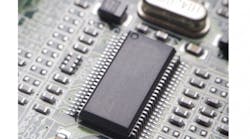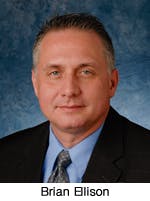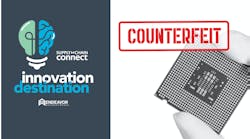If there’s one thing an engineer or procurement manager should do before buying from an independent distributor, it’s a big chunk of homework. It’s always been important to make sure you know your supplier. But some of the nation’s largest independent distributors say the situation has risen to new heights in light of government regulations placing the onus on contractors for bad parts finding their way into the defense supply chain.
Passage of the National Defense Authorization Act (NDAA) nearly two years ago set in motion a new set of requirements for contractors supplying products and equipment to military and other high-reliability markets, making 2013 a year of change for both the independent and authorized distributors that supply those companies with electronic components. Both have dealt with a flood of inquiries seeking that they have quality assurance and counterfeit mitigation plans in place, and many on the independent side have had to step up their sourcing, testing, and inspection capabilities. As original equipment manufacturers (OEMs) and contract manufacturers face financial liabilities should counterfeits find their way into their products, the trickle-down effect has put a spotlight on distributors—especially those that specialize in obsolete and hard-to-find parts.
“Obviously, money talks,” says Paul Elefonte, executive vice president of diminishing manufacturing sources (DMS) for New York-based independent distributor Crestwood Technology Group, which supplies obsolete and end-of-life components to defense, aerospace, medical, and telecommunications customers. “The government finally put the onus on the contractor [by saying] ‘if you deliver us product with counterfeit material or suspect counterfeit material, we won’t foot the bill to rework or replace it.’ This spawned an acceleration of the processes that we already had in place.”
Those processes include strict sourcing arrangements and testing and inspection programs that combat the moving target that is counterfeit electronics. As detection methods improve, counterfeiters look for new ways to outsmart them, creating a continuing need for heightened detection capabilities. Such capabilities are the fee for entry to this increasingly competitive marketplace, and Elefonte and others say it’s changing the independent distribution landscape. They anticipate fewer players in the game and changing roles as suppliers find their niche in what can only become an even tougher environment.
“Not all independent distributors are created equal,” says Elefonte, pointing to the post-NDAA climate as a game-changer in the independent field. “That they’re all the same has never been less true.”
A Thinning Herd
Perhaps the greatest change will be a smaller field of independent competitors in the future. As the stakes increase, only the best are likely to win the lion’s share of business, many distributors reason, leaving companies to close their doors or find new roles to play in the supply chain. Brian Ellison, president of large independent distributor America II Electronics, points to what he calls a “natural progression” in the franchised market years ago in which consolidation led to a smaller pool of distributors.
“We see the same thing happening in the independent channel,” says Ellison, pointing to tougher requirements in defense circles that are having a trickle-down effect into commercial markets, making it increasingly difficult for companies to compete. “It will take some time for [this] to take hold, but the bar is being raised without a doubt.”
Elefonte agrees, pointing to economic and political factors as key reasons for an anticipated “thinning of the herd.” A difficult post-2008 economic climate and dwindling domestic defense budgets make it tougher for everyone to compete for new business, and the Senate Armed Services Committee hearings of 2011 and resulting NDAA requirements have only complicated matters, he explains.
“Really what we’ve seen [is that] independent distributors are going to have to make a choice,” Elefonte says. “[They will have to] make the investment that top independent distributors have made in equipment, testing ,and inspection [programs], or they’ll have to stick to simply being a parts mover and moving the parts up the chain to [others] who do the testing and so forth.
“That’s what I’m seeing—a thinning of the herd, and that there will really only be two places in this sector: you get the material and sell it up the chain or you can be one of the final gatekeepers, those who will remain on the [approved vendor list] of the big contractors.”
Meeting New Requirements
The U.S. Senate’s late 2011 Armed Services Committee hearings on the problem of counterfeit electronics marked a turning point in the anti-counterfeit fight. Not only did the hearings address the large and growing problem of counterfeit components entering the defense supply chain, they also helped raise public awareness of the issue and spurred action in the contractor community. Distributors say the hearings caused many contractors who had been slow to develop anti-counterfeit policies to finally begin doing so, which signaled a key change for many component suppliers.
“There were some very responsible large enterprises—contractors—who were on the forefront and had been working on [purchasing] standards since the 2006 timeframe. There were other contractors that were laggards, so [the hearings] really drove the latter to get their policies moving and in place,” explains Elefonte, noting that suppliers who were aligned with the forward-thinking contractors had a leg up in the post-NDAA environment.
“In 2011, we were prepared,” says Elefonte, pointing to Crestwood Technology’s long-held focus on anti-counterfeit procedures. “When you looked under the rock, we were ready to go with the equipment, staff, and processes we’d been working on for years. A lot of the independent market had to flip a switch and try to play catch-up. For us it was continual refining and continuing with the path that we were on.”
That path includes three key capabilities customers should look for in an independent distributor: on-staff engineers and technical employees with special training and industry certification in counterfeit mitigation procedures, the most up-to-date test and inspection equipment available to verify parts authenticity, and their own approved supplier list. Such capabilities reinforce what Elefonte calls a “good in, good out” policy.
“We really take the attitude here that what we’re purchasing is valid material. We’re not trying to catch bad stuff,” he says, adding that testing and inspection programs should be designed to reinforce good sourcing practices. “It’s a shift in thinking, really; a zero defect and zero counterfeit [philosophy].”
America II’s Ellison agrees.
“It’s really about testing and the quality processes that you have in place,” he says. “But it’s also about vendor qualification processes that are very stringent, and it’s about having those direct relationships and how you mitigate [counterfeit] through that.”
New Roles to Play
The prediction that independents will take on new roles going forward is already taking shape. In a slightly different twist, America II Electronics is a pointed example of a company charting a new course in a changing business environment. The distributor has adopted what it calls a “blended distribution model,” in which America II represents a handful of franchised distribution lines in addition to its business filling the need for obsolete and hard-to-find parts.
To date, America II buys direct from more than 400 manufacturers and has 14 authorized lines. The philosophy is aimed at building business with existing customers while also reaching out to new ones that may be skeptical about sourcing components from the independent market.
“In the past, we’ve been the shortage buy for our customers. That endears us to some, but scares some out of our realm,” Ellison explains. “We’ve grown to just over 400 manufacturers we buy direct from and now we’re also taking on franchised and authorized lines. [Doing both] ensures that we have that channel into the component manufacturer.”
It also helps build the necessary confidence required in the distributor-customer relationship, Ellison says.
“We’ve got the customers we’ve done business with for many years, and their confidence level is high,” he says, pointing to potential customers, particularly in some industrial segments, who hesitate to buy from independents due to stringent sourcing requirements. “When we can offer the franchised piece, that’s a positive for them. And as their confidence builds over time, we’re able to expand our business.”
The blended model doesn’t reduce the need for testing, inspection, and other quality control measures, however. Ellison emphasizes the independent distributor’s need to maintain tight control of the supply chain from the start as a way to ensure confidence throughout the channel.
“For us it’s about controlling the supply chain to begin with, and then we have our in-house testing, so that allows us to mitigate a lot of the counterfeiting processes,” he explains. “There’s so much to it. We’re a part of IDEA [Independent Distributors of Electronics Association], which is a collective of independent distributors from around the world, and one of the main things we talk about is that counterfeiters are the enemy and how we can protect customers and suppliers.
“This is a global problem, and globally it’s taken seriously.”









